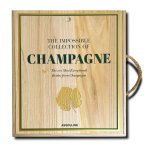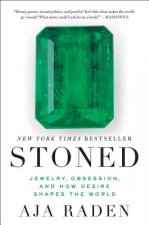
Kód: 05119770
Caviar with Champagne
Autor Jukka Gronow
'Life has become more joyous, comrades.' Josef Stalin, 1936Stalin's Russia is best known for its political repression, forced collectivization and general poverty. Caviar with Champagne presents an altogether different aspect of S ... celý popis
- Jazyk:
 Angličtina
Angličtina - Väzba: Brožovaná
- Počet strán: 256
Nakladateľ: Bloomsbury Publishing, 2003
- Viac informácií o knihe

Mohlo by sa vám tiež páčiť
-

Caviar with Champagne
212.06 € -

The Caviar Encyclopedia
50.04 € -

FashionEast
28.95 € -5 % -

The Psychology of Fashion
16.38 € -1 % -

Kitcho: Japan's Ultimate Dining Experience
54.39 € -13 % -

From Crackers...To Caviar
15.37 € -

Russian Caviar
19.50 € -

Champagne Magnum Opus
85.66 € -4 % -

Allied Tanks at El Alamein 1942
14.17 € -23 % -

The Impossible Collection of Champagne
1380.73 € -

Baptism of Fire
28.95 € -6 % -

Armstrong's Handbook of Performance Management
250.27 € -

The Sacred Feminine
27.34 € -

Unexpected Dad: Gay Romance
13.14 € -

NAOMI: OR, BOSTON, TWO HUNDRED YEARS AGO
46.55 € -
![Champagne [Boxed Book & Map Set] Champagne [Boxed Book & Map Set]](https://media.libris.to/jacket/12374342t.jpg)
Champagne [Boxed Book & Map Set]
88.48 € -

Teaching Mindfulness
130.01 € -

Vintage Champagne on the Edge of Space
12.16 € -15 % -

Naomi of the Arizona Territory
38.30 € -

Golem
11.96 € -14 % -

Objective First Student's Pack (Student's Book without Answers with CD-ROM, Workbook without Answers with Audio CD)
45.44 € -

Fetish Fashion
20.70 € -4 % -

Caviar par Kaviari
62.13 € -

Faszien-Krafttraining
24.83 € -

Dark Call - Du wirst mich nicht finden
15.17 € -9 % -

Murárske povesti a príbehy
6.83 € -23 % -

Bod klamu
12.76 € -23 % -

Camino Primitivo
30.66 € -5 %
Darujte túto knihu ešte dnes
- Objednajte knihu a vyberte Zaslať ako darček.
- Obratom obdržíte darovací poukaz na knihu, ktorý môžete ihneď odovzdať obdarovanému.
- Knihu zašleme na adresu obdarovaného, o nič sa nestaráte.
Viac informácií o knihe Caviar with Champagne
Nákupom získate 160 bodov
 Anotácia knihy
Anotácia knihy
'Life has become more joyous, comrades.' Josef Stalin, 1936Stalin's Russia is best known for its political repression, forced collectivization and general poverty. Caviar with Champagne presents an altogether different aspect of Stalin's rule that has never been fully analyzed - the creation of a luxury goods society. At the same time as millions were queuing for bread and starving, drastic changes took place in the cultural and economic policy of the country, which had important consequences for the development of Soviet material culture and the promotion of its ideals of consumption.The 1930s witnessed the first serious attempt to create a genuinely Soviet commercial culture that would rival the West. Government ministers took exploratory trips to America to learn about everything from fast food hamburgers to men's suits in Macy's. The government made intricate plans to produce high-quality luxury goods en masse, such as chocolate, caviar, perfume, liquor and assorted novelties. Perhaps the best symbol of this new cultural order was Soviet Champagne, which launched in 1936 with plans to produce millions of bottles by the end of the decade. Drawing on previously neglected archival material, Jukka Gronow examines how such new pleasures were advertised and enjoyed. He interprets Soviet-styled luxury goods as a form of kitsch and examines the ideological underpinnings behind their production.This new attitude toward consumption was accompanied by the promotion of new manners of everyday life. The process was not without serious ideological contradictions. Ironically, a factory worker living in the United States - the largest capitalist society in the world - would have been hard-pressed to afford caviar or champagne for a special occasion in the 1930s, but a Soviet worker theoretically could (assuming supplies were in stock). The Soviet example is unique since the luxury culture had to be created entirely from scratch, and the process was taken extremely serio
 Parametre knihy
Parametre knihy
Zaradenie knihy Knihy po anglicky Humanities History History: specific events & topics
63.58 €
- Celý názov: Caviar with Champagne
- Autor: Jukka Gronow
- Jazyk:
 Angličtina
Angličtina - Väzba: Brožovaná
- Počet strán: 256
- EAN: 9781859736388
- ISBN: 1859736386
- ID: 05119770
- Nakladateľ: Bloomsbury Publishing
- Hmotnosť: 322 g
- Rozmery: 158 × 234 × 16 mm
- Dátum vydania: 01. October 2003
Obľúbené z iného súdka
-

Man's Search for Meaning
7.03 € -6 % -

Women, Race & Class
10.25 € -19 % -

Pianist
12.56 € -12 % -

Out Of Place
12.06 € -23 % -

Little History of Economics
14.87 € -8 % -

Laughter in Ancient Rome
19.90 € -11 % -

Civilization and Capitalism, 15th-18th Century
67.26 € -

Armies of Medieval Burgundy 1364-1477
15.68 € -14 % -

Night
9.95 € -22 % -

Society of the Spectacle
11.55 € -

Imperialism: The Highest Stage of Capitalism
7.73 € -23 % -

Man's Search For Meaning
16.28 € -23 % -

Homo Deus
12.06 € -23 % -

Ordinary Men
11.45 € -19 % -

Black Earth
13.36 € -19 % -

The Complete MAUS
18.69 € -13 % -

The Rape of Nanking
16.28 € -22 % -

Madness and Civilization
17.59 € -8 % -

Conquerors
12.06 € -15 % -

Stoned
10.95 € -23 % -

Twelve Years a Slave
3.61 € -22 % -

At Home
12.06 € -22 % -

Origins of Museums
57.91 € -17 % -

Measure of a Man
14.47 € -

Delirious New York
30.16 € -15 % -

Eichmann in Jerusalem
11.45 € -19 % -

Mein Kampf - The Ford Translation
41.92 € -

Bloodlands
13.36 € -19 % -

Guns, Germs and Steel
13.36 € -19 % -

Cold War Submarines
37.70 € -17 % -

Fall of Public Man
16.28 € -23 % -

Che Guevara
24.43 € -13 % -

Dancing In The Streets
12.06 € -23 % -

Fix the Pumps
15.17 € -15 % -

Blue
38.30 € -5 % -

Revolutionary Yiddishland
13.26 € -15 % -

Commandant Of Auschwitz
12.06 € -22 % -

Jewish State
12.06 € -

Eichmann in Jerusalem
15.07 € -21 % -

Reflections on the Revolution in France
9.95 € -22 % -

Wall Street and the Bolshevik Revolution
14.17 € -23 % -

Corgi Toys
17.08 € -5 % -

Night
10.95 € -23 % -

Wreck of the Titan
13.56 € -15 % -

McMafia
12.06 € -22 % -

Intimate History of Humanity
14.17 € -23 % -

Feminism: A Very Short Introduction
9.95 € -22 % -

White Gold
14.17 € -23 % -

Twelve Who Ruled
25.23 € -9 %
Osobný odber Bratislava a 2642 dalších
Copyright ©2008-24 najlacnejsie-knihy.sk Všetky práva vyhradenéSúkromieCookies



 21 miliónov titulov
21 miliónov titulov Vrátenie do mesiaca
Vrátenie do mesiaca 02/210 210 99 (8-15.30h)
02/210 210 99 (8-15.30h)